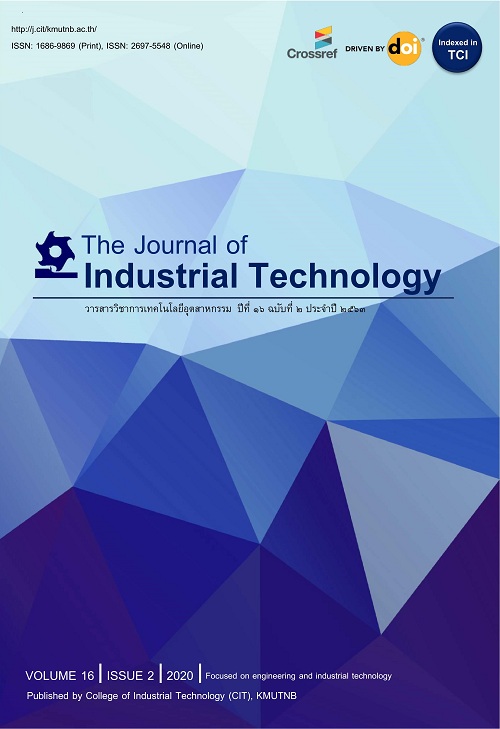การเกิดคาร์บอเนชั่นของคอนกรีตในสภาวะเร่งและสภาวะจริง
Accelerated and Real Carbonation Situations of Concrete
Abstract
บทคัดย่อ
การวิจัยครั้งนี้เป็นการศึกษาการเกิดคาร์บอเนชั่นของคอนกรีตที่แทนที่บางส่วนด้วยเถ้าลอย ตะกรันเตาถลุงเหล็กบดละเอียด และผงหินปูน ในปูนซีเมนต์ปอร์ตแลนด์ประเภทที่ 1 ใช้ตัวอย่างคอนกรีตขนาด 100 x 100 x 100 มม. โดยการบ่มน้ำ 28 วัน หลังจากครบเวลาที่กำหนดนำตัวอย่างคอนกรีตไปสัมผัสกับก๊าซคาร์บอนไดออกไซด์ 2 สภาวะ คือ นำคอนกรีตเข้าตู้เร่งปฏิกิริยาคาร์บอเนชั่นเป็นเวลา 90 วัน และนำไปไว้ในสภาพแวดล้อมที่สัมผัสก๊าซคาร์บอนไดออกไซด์ ถนนเพชรเกษม กิโลเมตรที่ 52 อำเภอเมือง จังหวัดนครปฐม เป็นเวลา 90 180 และ 270 วัน ผลการศึกษาพบว่า การเกิดคาร์บอเนชั่นของคอนกรีตผสมเถ้าลอยและผสมตะกรันเตาถลุงเหล็กบดละเอียดมีค่ามากกว่าของปูนซีเมนต์ปอร์ตแลนด์ประเภทที่ 1 ล้วน ในขณะที่การเกิดคาร์บอเนชั่นของคอนกรีตผสมผงหินปูนมีค่าใกล้เคียงกับของปูนซีเมนต์ปอร์ตแลนด์ประเภทที่ 1 ล้วน ส่วนการเกิดคาร์บอเนชั่นของคอนกรีตในสภาวะเร่ง ซึ่งมีการสัมผัสก๊าซคาร์บอนไดออกไซด์ที่เข้มข้นมากกว่า มีค่ามากกว่าสภาวะจริงที่สัมผัสก๊าซคาร์บอนไดออกไซด์ ที่เข้มข้นน้อยกว่า นอกจากนี้สัมประสิทธิ์คาร์บอเนชั่นของคอนกรีตผสมเถ้าลอยและตะกรันเตาถลุงเหล็กบดละเอียดมีค่ามากกว่าของปูนซีเมนต์ปอร์ตแลนด์ประเภทที่ 1 ล้วน ในขณะที่สัมประสิทธิ์คาร์บอเนชั่นของคอนกรีตผสม ผงหินปูนมีค่าใกล้เคียงเมื่อเทียบกับของปูนซีเมนต์ปอร์ตแลนด์ประเภทที่ 1 ล้วน สุดท้ายสามารถทำนายความลึก คาร์บอเนชั่นของคอนกรีตในสภาวะจริงจากความลึกคาร์บอเนชั่นของคอนกรีตในสภาวะเร่งได้
Abstract
This research aims to study the carbonation of concrete partially replaced fly ash, ground granulated blast-furnace slag (GGBS) and limestone powder in ordinary Portland cement (OPC). The concrete 100 x 100 x 100 mm specimens were used in this study. The concrete samples were cured in water for 28 days, and then exposed to carbon dioxide. Concrete specimens were divided in two parts. The first part was exposed to carbonation in carbonation catalyst chamber for 90 days. The second one was placed in the atmosphere exposed to carbon dioxide at kilometer No.52 on Phetkasem Road, Muang district, Nakhon Pathom Province for 90, 180 and 270 days. The results indicated that the carbonation of concrete with fly ash and concrete with GGBS was significantly higher than that of OPC concrete, while the carbonation of concrete with limestone powder was close to that of OPC concrete. Furthermore, the carbonation of concrete in carbonation catalyst chamber, having more carbon dioxide, was greater than that of concrete in atmosphere exposed. In addition, the carbonation coefficient of concrete with fly ash and concrete with GGBS was higher than that of OPC concrete, while the carbonation coefficient of concrete with limestone powder was nearly the same when compared to that with OPC concrete. Finally, the carbonation depth of concrete exposed to carbon dioxide in the real situation can predict from the depth of carbonation of concrete in accelerated situation.
Keywords
Refbacks
- There are currently no refbacks.






